Search for answers or browse about Sintel Forms.
RAG area chart
RAG charts can be used to indicate, how well a project is doing using the series traffic lights. A red traffic light indicates problems, amber everything is okay, green things going well.
With Sintel BI are you able to create both RAG line charts and RAG Area charts. If you would like to learn more about RAG line charts click here.

1. Why use a RAG chart?
For some charts, you can use just use one traffic light colour to indicate the overall project status. The RAG system can be used in projects to indicate how well things are going. It can be used for things like budget, quality, resources, performances and project timelines. A RAG chart gives an instant indication to senior management of how a project is going and if further help or intervention is needed.

2. What Colours should I assign to a value?
Understanding RAG definitions is the first step to utilising this chart to its full potential.
Red
Red should be used when there are significant issues with the project or the process it. It can be used when one area of project viability such as budget, scope or time goes beyond the tolerance levels agreed at the start. Red signifies that the matter needs to be escalated to senior management for support immediately.
Amber
If there is a problem that is having a negative effect on the project performance or the project viability is at risk, then an amber rating is appropriate.
More often than not, amber problems can be dealt with by the projects team and the project manager. However, in some circumstances, it might be a good idea to senior management to such issues.
Green
Green means Good! Everything is functioning as expected and the project performance is as planned. No action is needed.
Now you have a clear understanding of how the RAG colours should be assigned it’s time to learn how to add a RAG chart.
3. How to add and configure a RAG area chart.
The following steps explain the data configuration of the RAG area chart:
- Drag and drop the RAG area chart icon from the toolbox into the design panel.
- Resize the widget as required.
- Select your chart and in the properties section, you can name the chart and change any settings you wish.
- You can then select assign data and select your data source.Please note that before adding a component you will need to define a data source.
- Drag and drop the relevant columns into the value, column and row section.
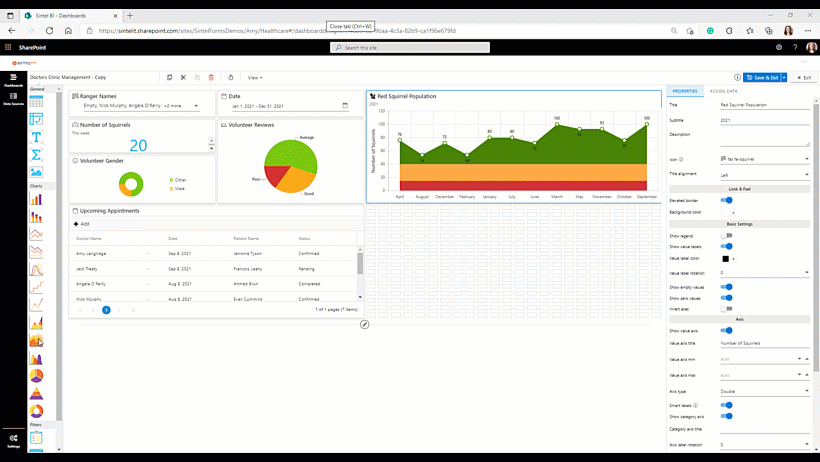
Adding the Rag Area Chart
4. Properties menu options
It is recommended that you check out the properties menu options to format your RAG area chart in the way that best suits the data you are depicting.
The following screenshots show the various properties menu options based on the column chart section.
Naming the Component
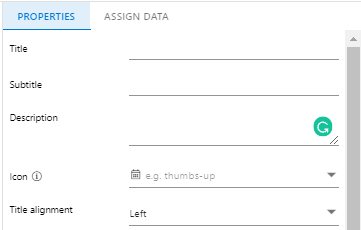
Naming the Component
Title – This allows you to set a name for the component
Subtitle – This allows you to set a subtitle for the component.
Description – This allows you to show additional information in the form of a tooltip. It’s beneficial as it gives the user additional information without affecting the visualization.
Icon – Sintel Forms and Sintel BI both have Font Awesome embedded. This enables you to add
Title alignment – This determines the appearance and orientation of the component’s title. You can choose to align your text left, centre or right.
Look & Feel

Look & Feel
Elevated Border – You can switch the elevated border on and off of your component depending on what you like best.
Background Colour – You can change the background colour of the component to any colour you like. If you have specific brand guidelines you are adhering to you can paste in the HEX code directly.
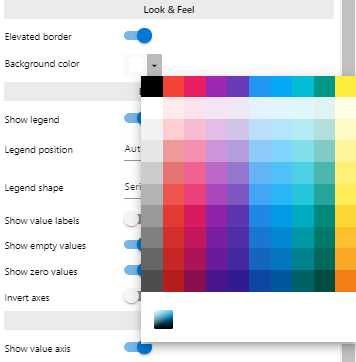
Select your background colour
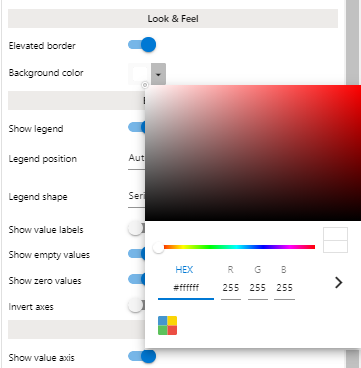
or paste in the HEX code directly to comply with brand guidelines
Basic Settings
Show legend – A legend is an area of a chart describing each of the parts of the chart. You can switch on and off the visibility of the legend.
Legend position – You can choose the position in which the legend appears in relation to the chart. The options are Auto, Top, Left, Bottom and Right.

Legend positioned on the bottom

Legend positioned on the right
Legend shape – You can choose the shape of the bullet points of the legend. Your options are SeriesType (Which mimics the kind of chart you have added), Circle, Pentagon, Triangle and Rectangle,
Show value labels – You can switch on and off the visibility of the value labels for each individual column.
If you choose for the labels to become visible you can also choose the colour of those labels.
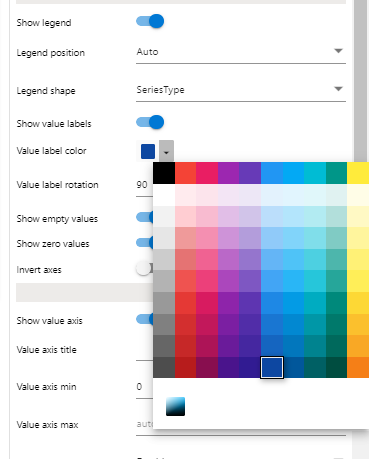
Choose a colour for your legend labels
You can also decide the rotation of these labels: -90, -45, 0, 45, 90

Value label rotation: 0°

Value label rotation: 45°
Show empty values – You can choose whether or not to show empty values.
Show zero values – You can choose whether or not to show 0 values on your table.
Invert axes – Shows the X & Y axes in reverse

Invert Axes
Axis
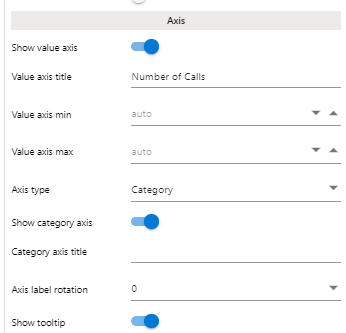
Show value axis – You can choose to show or hide the value axis on your chart

Value Axis shown

Value Axis hidden
Value axis title – You can add a title to the value axis for example: ‘Number of Calls’.

Title ‘Number of Squirrels’ given to value axis

Value Axis min set to 30
Value axis min – You can set a minimum value at which you would like to start displaying data on a chart. For example, you might just want to display the weeks in which you had over 16 abandoned calls to your helpline.
Value axis max – Similarly you can set a maximum value at which you would like to display data on a chart.
Axis type – You can set your axis to be: double, logarithmic or category.
If you set it to double you also have the option to enable Smart labels which when enabled abbreviate the numeric axis labels.
You can also choose to show or hide the category axis.
If you set your axis type to be logarithmic or category you have the option to show or hide the category axis.
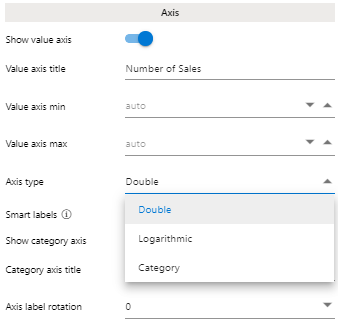
Setting the Axis Type

Axis type set to double

Axis type set to category
Show tooltip – The tooltip will appear when you hover over one of the columns and it will show you the value for that column. You can choose to show or hide this column.
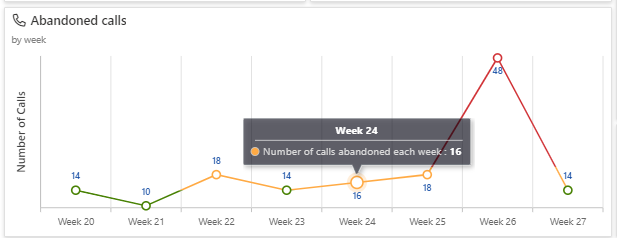
tooltip set to ‘Show’
Series
Within the series section, you can change the title that appears at the bottom of your chart, you can change the colour of your chart and you can also change the chart type.

Series section of the properties pane
Once you have added your RAG area chart component and assigned data to it, make sure you save your work.
If you liked this article and would like to learn more about other components, click here.
To learn more about Sintel check our features or testimonials.
If you would like to learn more about Sintel Forms or Sintel BI book a no-obligation demo.
For the latest updates follow us on LinkedIn/Twitter & YouTube.
